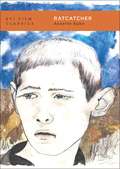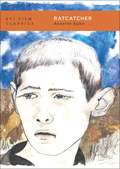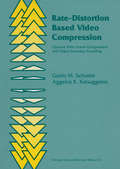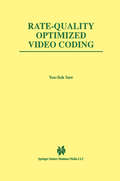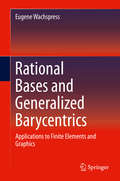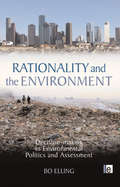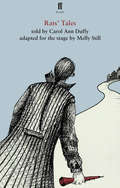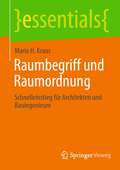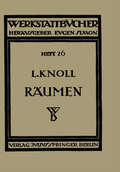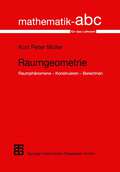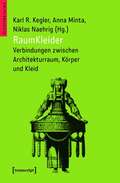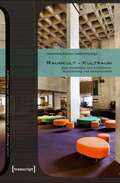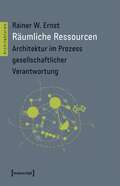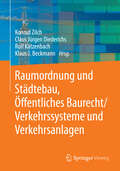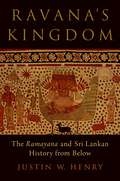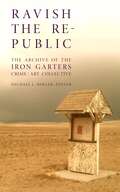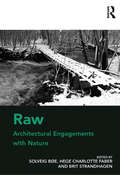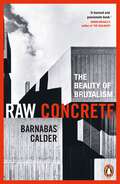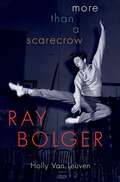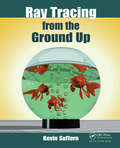- Table View
- List View
Ratcatcher (BFI Film Classics)
by Annette KuhnLynne Ramsay's bleak yet beautifully photographed debut unflinchingly portrays life on a Glasgow housing estate during the 1973 refuse collectors' strike, as seen through the eyes of 12-year-old James Gillespie (William Eadie). After James's friend falls into a canal and drowns, James becomes increasingly withdrawn. As bags of rubbish pile up and rats move in, James finds solace in his friendships with Kenny, an odd boy who loves animals, and Margaret Anne,a teenage misfit.Annette Kuhn's study of the film, the first to offer an overarching account of Ramsay's work, considers the director's background and Ratcatcher alongside her earlier films. Kuhn traces the film's production history in the context ofScottish media and literary cultures, and its cinematic influences, while acknowledging the distinctiveness of Ramsay's poetic, visionary style. Kuhn draws on interviews with Ramsay and others involved in the film's production, and combines this with a close reading of selected passages to provide an in-depth and illuminating analysis of the film's poetic style and its aesthetics, including an examination of its construction of a child's world through a highly distinctive organisation of cinematic space.
Ratcatcher (BFI Film Classics)
by Annette KuhnLynne Ramsay's bleak yet beautifully photographed debut unflinchingly portrays life on a Glasgow housing estate during the 1973 refuse collectors' strike, as seen through the eyes of 12-year-old James Gillespie (William Eadie). After James's friend falls into a canal and drowns, James becomes increasingly withdrawn. As bags of rubbish pile up and rats move in, James finds solace in his friendships with Kenny, an odd boy who loves animals, and Margaret Anne,a teenage misfit.Annette Kuhn's study of the film, the first to offer an overarching account of Ramsay's work, considers the director's background and Ratcatcher alongside her earlier films. Kuhn traces the film's production history in the context ofScottish media and literary cultures, and its cinematic influences, while acknowledging the distinctiveness of Ramsay's poetic, visionary style. Kuhn draws on interviews with Ramsay and others involved in the film's production, and combines this with a close reading of selected passages to provide an in-depth and illuminating analysis of the film's poetic style and its aesthetics, including an examination of its construction of a child's world through a highly distinctive organisation of cinematic space.
Rate-Distortion Based Video Compression: Optimal Video Frame Compression and Object Boundary Encoding
by Guido M. Schuster Aggelos KatsaggelosOne of the most intriguing problems in video processing is the removal of the redundancy or the compression of a video signal. There are a large number of applications which depend on video compression. Data compression represents the enabling technology behind the multimedia and digital television revolution. In motion compensated lossy video compression the original video sequence is first split into three new sources of information, segmentation, motion and residual error. These three information sources are then quantized, leading to a reduced rate for their representation but also to a distorted reconstructed video sequence. After the decomposition of the original source into segmentation, mo tion and residual error information is decided, the key remaining problem is the allocation of the available bits into these three sources of information. In this monograph a theory is developed which provides a solution to this fundamental bit allocation problem. It can be applied to all quad-tree-based motion com pensated video coders which use a first order differential pulse code modulation (DPCM) scheme for the encoding of the displacement vector field (DVF) and a block-based transform scheme for the encoding of the displaced frame differ ence (DFD). An optimal motion estimator which results in the smallest DFD energy for a given bit rate for the encoding of the DVF is also a result of this theory. Such a motion estimator is used to formulate a motion compensated interpolation scheme which incorporates a global smoothness constraint for the DVF.
Rate-Quality Optimized Video Coding (The Springer International Series in Engineering and Computer Science #486)
by Yoo-Sok SawRate-Quality Optimized Video Coding discusses the matter of optimizing (or negotiating) the data rate of compressed digital video and its quality, which has been a relatively neglected topic in either side of image/video coding and tele-traffic management. Video rate management becomes a technically challenging task since it is required to maintain a certain video quality regardless of the availability of transmission or storage media. This is caused by the broadband nature of digital video and inherent algorithmic features of mainstream video compression schemes, e.g. H.261, H.263 and MPEG series. In order to maximize the media utilization and to enhance video quality, the data rate of compressed video should be regulated within a budget of available media resources while maintaining the video quality as high as possible. In Part I (Chapters 1 to 4) the non-stationarity of digital video is discussed. Since the non-stationary nature is also inherited from algorithmic properties of international video coding standards, which are a combination of statistical coding techniques, the video rate management techniques of these standards are explored. Although there is a series of known video rate control techniques, such as picture rate variation, frame dropping, etc., these techniques do not view the matter as an optimization between rate and quality. From the view of rate-quality optimization, the quantizer is the sole means of controling rate and quality. Thus, quantizers and quantizer control techniques are analyzed, based on the relationship of rate and quality. In Part II (Chapters 5 and 6), as a coherent approach to non-stationary video, established but still thriving nonlinear techniques are applied to video rate-quality optimization such as artificial neural networks including radical basis function networks, and fuzzy logic-based schemes. Conventional linear techniques are also described before the nonlinear techniques are explored. By using these nonlinear techniques, it is shown how they influence and tackle the rate-quality optimization problem. Finally, in Chapter 7 rate-quality optimization issues are reviewed in emerging video communication applications such as video transcoding and mobile video. This chapter discusses some new issues and prospects of rate and quality control in those technology areas. Rate-Quality Optimized Video Coding is an excellent reference and can be used for advanced courses on the topic.
Rational Bases and Generalized Barycentrics: Applications to Finite Elements and Graphics
by Eugene WachspressThis three-part volume explores theory for construction of rational interpolation functions for continuous patchwork approximation. Authored by the namesake of the Wachspress Coordinates, the book develops construction of basis functions for a broad class of elements which have widespread graphics and finite element application. Part one is the 1975 book “A Rational Finite Element Basis” (with minor updates and corrections) written by Dr. Wachspress. Part two describes theoretical advances since 1975 and includes analysis of elements not considered previously. Part three consists of annotated MATLAB programs implementing theory presented in Parts one and two.
Rationality and the Environment: Decision-making in Environmental Politics and Assessment
by Bo EllingEnvironmental assessment and management involve the production of scientific knowledge and its use in decision-making processes. The result is that within these essentially rational, political assessment frameworks, experts are creating and applying scientific knowledge for decision and management purposes that actually have strong ethical and aesthetic dimensions. Yet these rational political frameworks lack the tools to provide guidance on ethical and aesthetic issues that affect the wider public. This revolutionary work argues that ethical and aesthetic dimensions can only be brought into environmental politics and policies by citizens actively taking a stand on the specific matters in question. The author draws on Habermas? trisection of rationality as cognitive-instrumental, moral-practical and aesthetic-expressive, to suggest that truly effective environmental policy needs to activate all three approaches and not favour only the rational. To achieve this objective, the author argues that public participation in environmental policy and assessment is necessary to counteract the dictatorship of technical and economic instrumentality in environmental policy - the failure to take ethical and aesthetic rationalities into account - and, more importantly, how such policy is applied on the ground to shape our natural and material world.
Rationality and the Environment: Decision-making in Environmental Politics and Assessment
by Bo EllingEnvironmental assessment and management involve the production of scientific knowledge and its use in decision-making processes. The result is that within these essentially rational, political assessment frameworks, experts are creating and applying scientific knowledge for decision and management purposes that actually have strong ethical and aesthetic dimensions. Yet these rational political frameworks lack the tools to provide guidance on ethical and aesthetic issues that affect the wider public. This revolutionary work argues that ethical and aesthetic dimensions can only be brought into environmental politics and policies by citizens actively taking a stand on the specific matters in question. The author draws on Habermas? trisection of rationality as cognitive-instrumental, moral-practical and aesthetic-expressive, to suggest that truly effective environmental policy needs to activate all three approaches and not favour only the rational. To achieve this objective, the author argues that public participation in environmental policy and assessment is necessary to counteract the dictatorship of technical and economic instrumentality in environmental policy - the failure to take ethical and aesthetic rationalities into account - and, more importantly, how such policy is applied on the ground to shape our natural and material world.
Rats' Tales
by Carol Ann DuffyRats' Tales brings together a hugely entertaining, dark and magical cycle of folk tales from around the world. The volume contains two texts for each story: Poet Laureate Carol Ann Duffy's wonderful prose and Melly Still's lively dramatization. Rats' Tales celebrates the power of storytelling and will be published to coincide with the premiere at the Royal Exchange, Manchester, in November 2012. On Beasts and Beauties, on which Carol Ann Duffy and Melly Still also collaborated: 'The first night audience did not exit from the theatre, they hover-crafted out of it on a balloon of bliss.' Independent
Raumbegriff und Raumordnung: Schnelleinstieg für Architekten und Bauingenieure (essentials)
by Mario H. KrausRaum ist ein mehrdeutiger und gelegentlich umstrittener Begriff. Raumordnung beruht auf einem empfindlichen und veränderlichen gesellschaftlichen Gleichgewicht, das sich in den Rechtsgrundlagen und der alltäglichen Umsetzung widerspiegelt. In diesem essential werden Ansätze aus der Phänomenologie zur Einordnung der verschiedenen Raumbegriffe genutzt.
Räumen: Anwendung, Konstruktion und Herstellung der Räumnadeln. Fehler beim Räumen (Werkstattbücher #26)
by Leonhard KnollDieser Buchtitel ist Teil des Digitalisierungsprojekts Springer Book Archives mit Publikationen, die seit den Anfängen des Verlags von 1842 erschienen sind. Der Verlag stellt mit diesem Archiv Quellen für die historische wie auch die disziplingeschichtliche Forschung zur Verfügung, die jeweils im historischen Kontext betrachtet werden müssen. Dieser Titel erschien in der Zeit vor 1945 und wird daher in seiner zeittypischen politisch-ideologischen Ausrichtung vom Verlag nicht beworben.
Raumgeometrie: Raumphänomene — Konstruieren — Berechnen (Mathematik-ABC für das Lehramt)
by Kurt Peter MüllerDas Buch ist eine elementar gehaltene Einführung in die Raumgeometrie. Eine solche "Raumgeometrie" nimmt neben einer eher problemorientierten "Elementargeometrie" und einer systematischen "Abbildungsgeometrie" eine bedeutende Stelle innerhalb der Lehrerausbildung ein.
RaumKleider: Verbindungen zwischen Architekturraum, Körper und Kleid (Architekturen #37)
by Karl. R. Kegler Anna Minta Niklas NaehrigKleider sind Lebensentwürfe, ebenso wie Bauten und Architekturen. Reform, Modernität, Sachlichkeit und Regionalität veranschaulichen sich in Kleidung wie in architektonischen Formen. Architekten und Designer des 20. Jahrhunderts haben nicht allein über die Zusammenhänge von Architektur und Bekleidung geschrieben, sondern auch eigene Kleiderentwürfe angefertigt. Die Beiträge, in deren Zentrum neben Architektur und Mode auch Interieur und Film stehen, gehen den Wechselbeziehungen zwischen Architekturentwürfen und korrespondierenden Menschenbildern nach.
Raumkult - Kultraum: Zum Verhältnis von Architektur, Ausstattung und Gemeinschaft (Linzer Beiträge zur Kunstwissenschaft und Philosophie #10)
by Maximiliane Buchner Anna MintaDas tradierte Verständnis von Kultraum und Gemeinschaft befindet sich im Umbruch. Alternative Konzepte der Vergemeinschaftung schaffen neue auratische Architekturen und Räume, die häufig religiöse Referenzsysteme adaptieren: In Museen, Bibliotheken, Denkmalanlagen und Hochzeitskapellen etc. entstehen neue Orte der Gemeinschaft, deren Abgrenzung zum traditionellen Sakralraum oft unscharf ist. Die Beiträge des Bandes diskutieren aus verschiedenen geisteswissenschaftlichen Perspektiven religiös-auratische Raumkonzepte bestehender Sakraltopografien sowie neukonstituierter Kulträume im 20. und 21. Jahrhundert und bereichern damit die aktuellen Diskussionen um Raumgestaltung, Öffentlichkeit und Gemeinschaftsstiftung.
Räumliche Ressourcen: Architektur im Prozess gesellschaftlicher Verantwortung (Architekturen #47)
by Rainer W. ErnstRaum ist eine gesellschaftliche Ressource. Rainer W. Ernst zeigt: Die Qualität unserer Lebensräume wird einerseits durch unterschiedliche Eigenschaften bestimmt und andererseits durch demokratisierte Entscheidungsprozesse bilanziert und geprägt. Ihre Herkunft, Wirkung, Verfügbarkeit und Gestaltbarkeit zu begreifen und interessenspezifisch zu kombinieren und zu verorten, verlangt der Architektur das neue Arbeitsfeld der »Möglichkeitsräume« ab. Das Buch macht deutlich, wie Architekt_innen in diesem rückkoppelnden Verfahren zusätzliche Möglichkeiten für die kreative Gestaltung von Lebensräumen finden können.
Raumordnung und Städtebau, Öffentliches Baurecht / Verkehrssysteme und Verkehrsanlagen
by Konrad Zilch Claus Jürgen Diederichs Rolf Katzenbach Klaus J. BeckmannStudierende des Bauingenieurwesens werden durch das kompakte Wissen auf ihre komplexen Aufgaben vorbereitet und auf Vertiefungsmöglichkeiten hingewiesen. Praktikern bietet das Werk die Möglichkeit, ihren Wissensstand zu den Grundlagen zu aktualisieren.
Ravana's Kingdom: The Ramayana and Sri Lankan History from Below
by Justin W. HenryRavana, the demon-king antagonist from the Ramayana, the ancient Hindu epic poem, has become an unlikely cultural hero among Sinhala Buddhists over the past decade. In Ravana's Kingdom, Justin W. Henry delves into the historical literary reception of the epic in Sri Lanka, charting the adaptions of its themes and characters from the 14th century onwards, as many Sri Lankan Hindus and Buddhists developed a sympathetic impression of Ravana's character, and through the contemporary Ravana revival, which has resulted in the development of an alternative mythological history, depicting Ravana as king of the Sri Lanka's indigenous inhabitants, a formative figure of civilizational antiquity, and the direct ancestor of the Sinhala Buddhist people. Henry offers a careful study of the literary history of the Ramayana in Sri Lanka, employing numerous sources and archives that have until now received little to no scholarly attention, as well as the 21st century revision of a narrative of the Sri Lankan people-a narrative incubated by the general public online, facilitated by social media and by the speed of travel of information in the digital age. Ravana's Kingdom offers a glimpse into a centuries-old, living Ramayana tradition among Hindus and Buddhists in Sri Lanka-a case study of the myth-making process in the digital age.
Ravana's Kingdom: The Ramayana and Sri Lankan History from Below
by Justin W. HenryRavana, the demon-king antagonist from the Ramayana, the ancient Hindu epic poem, has become an unlikely cultural hero among Sinhala Buddhists over the past decade. In Ravana's Kingdom, Justin W. Henry delves into the historical literary reception of the epic in Sri Lanka, charting the adaptions of its themes and characters from the 14th century onwards, as many Sri Lankan Hindus and Buddhists developed a sympathetic impression of Ravana's character, and through the contemporary Ravana revival, which has resulted in the development of an alternative mythological history, depicting Ravana as king of the Sri Lanka's indigenous inhabitants, a formative figure of civilizational antiquity, and the direct ancestor of the Sinhala Buddhist people. Henry offers a careful study of the literary history of the Ramayana in Sri Lanka, employing numerous sources and archives that have until now received little to no scholarly attention, as well as the 21st century revision of a narrative of the Sri Lankan people-a narrative incubated by the general public online, facilitated by social media and by the speed of travel of information in the digital age. Ravana's Kingdom offers a glimpse into a centuries-old, living Ramayana tradition among Hindus and Buddhists in Sri Lanka-a case study of the myth-making process in the digital age.
Ravish the Republic: The Archives of the Iron Garters Crime/Art Collective
by Michael L. BergerIn the 2011 book Dark Matter: Art and Politics in the Age of Enterprise Culture, the artist Gregory Sholette posits that we are living in an era of surplus creative energies concentrated in a teeming archive of artists, the poor, the “unskilled” and the “economically invisible.” It is a potentially disruptive archive that capitalism can’t always manage but can still hope to eventually exploit and assimilate. Within this archive seethes creative energy that can extend itself in unique and unsettling ways, across multiple categories and disciplines. Often, however such energy is captured by the winners and arbiters in our “risk society” and thereby sanitized and neutralized. So it becomes necessary for artists, theorists, writers and activists to be versatile in their tactics, cryptic and evasive in their manifestations and criminally implacable in their visions. The Iron Garters are an “art gang” that masquerades, disseminates and performs as your archetypal “criminals,” “outcasts” “mystics,” “losers” and “lunatics”: in short, a vital and necessary social surplus. Their antics have been traced back to Jean Genet’s novel The Thief’s Journal, the films of Kenneth Anger, as well as the Dada poems of Baroness Elsa and Hugo Ball. Yet still other Garters have been nourished on the Vienna Actionists, Genesis P-Orridge, Diamanda Galas, Gilles Deleuze, Samuel Delany, and the dulcet sounds of The Cramps. With a critical and aesthetic arsenal salvaged from underground “kulchurs” and academia’s collective libido, the Iron Garters are not afraid to demand excitement along with analysis, frenzy coupled to resistance, and fashion inseparable from infiltration. Founded in San Francisco on a full moon night after a “deathpunk” show, the original members grew adversely impacted by the economic invasions reducing a once great city to a tepid monoculture. Fueled by queer, antinomian, heretical and radical traditions, the Garters pilgrimaged into various trans-continental sanctuaries and beachheads, leaving behind them radiant paper trails of provocation and sedition. This volume is one such radiant paper trail.
Raw: Architectural Engagements With Nature
by Solveig Bøe Hege Charlotte FaberThrough cross-disciplinary explorations of and engagements with nature as a forming part of architecture, this volume sheds light on the concepts of both nature and architecture. Nature is examined in a raw intermediary state, where it is noticeable as nature, despite, but at the same time through, man’s effort at creating form. This is done by approaching nature from the perspective of architecture, understood, not only as concrete buildings, but as a fundamental human way both of being in, and relating to, the world. Man finds and forms places where life may take place. Consequently, architecture may be understood as ranging from the simple mark on the ground and primitive enclosure, to the contemporary megalopolis. Nature inheres in many aesthetic forms of expression. In architecture, however, nature emerges with a particular power and clarity, which makes architecture a raw kind of art. Even though other forms of art, as well as aesthetic phenomena outside the arts, are addressed, the analogy to architecture will be evident and important. Thus, by using the concept of ’raw’ as a focal point, this book provides new approaches to architecture in a broad sense, as well as other aesthetic and artistic practices, and will be of interest to readers from different fields of the arts and humanities, spanning from philosophy and theology to history of art, architecture and music.
Raw: Architectural Engagements with Nature
by Solveig Bøe Hege Charlotte FaberThrough cross-disciplinary explorations of and engagements with nature as a forming part of architecture, this volume sheds light on the concepts of both nature and architecture. Nature is examined in a raw intermediary state, where it is noticeable as nature, despite, but at the same time through, man’s effort at creating form. This is done by approaching nature from the perspective of architecture, understood, not only as concrete buildings, but as a fundamental human way both of being in, and relating to, the world. Man finds and forms places where life may take place. Consequently, architecture may be understood as ranging from the simple mark on the ground and primitive enclosure, to the contemporary megalopolis. Nature inheres in many aesthetic forms of expression. In architecture, however, nature emerges with a particular power and clarity, which makes architecture a raw kind of art. Even though other forms of art, as well as aesthetic phenomena outside the arts, are addressed, the analogy to architecture will be evident and important. Thus, by using the concept of ’raw’ as a focal point, this book provides new approaches to architecture in a broad sense, as well as other aesthetic and artistic practices, and will be of interest to readers from different fields of the arts and humanities, spanning from philosophy and theology to history of art, architecture and music.
Raw Concrete: The Beauty of Brutalism
by Barnabas CalderSHORTLISTED FOR THE ALICE DAVIS HITCHCOCK AWARD'Brilliant' Elain Harwood'Part history, part aesthetic autobiography, wholly engaging and liable to convince those procrastinators sitting (uncomfortably) on the concrete fence' Jonathan Meades'A learned and passionate book' Simon Bradley, author of The Railways‘A compelling and evocative read, meticulously researched, and filled with insight and passion’ Kate Goodwin, Head of Architecture, Royal Academy of ArtsThe raw concrete buildings of the 1960s constitute the greatest flowering of architecture the world has ever seen. The biggest construction boom in history promoted unprecedented technological innovation and an explosion of competitive creativity amongst architects, engineers and concrete-workers. The Brutalist style was the result.Today, after several decades in the shadows, attitudes towards Brutalism are slowly changing, but it is a movement that is still overlooked, and grossly underrated. Raw Concrete overturns the perception of Brutalist buildings as the penny-pinching, utilitarian products of dutiful social concern. Instead it looks a little closer, uncovering the luxuriously skilled craft and daring engineering with which the best buildings of the 1960s came into being: magnificent architectural visions serving clients rich and poor, radical and conservative.Beginning in a tiny hermitage on the remote north Scottish coast, and ending up backstage at the National Theatre, Raw Concrete embarks on a wide-ranging journey through Britain over the past sixty years, stopping to examine how eight extraordinary buildings were made – from commission to construction – why they have been so vilified, and why they are beginning to be loved. In it, Barnabas Calder puts forward a powerful case: Brutalism is the best architecture there has ever been, and perhaps the best there ever will be.
Ray Bolger: More than a Scarecrow
by Holly Van LeuvenBest remembered for his role as the Scarecrow in the 1939 MGM musical The Wizard of Oz, Ray Bolger led a rich and extraordinary career in the decade before and more than four decades after the creation of the film. Ray Bolger: More Than a Scarecrow is the first biography of this classic American entertainer, covering the luminous and forgotten career of the eccentric dancer outside of his burlap mask. The product of a fragmented, working-class Boston Irish family, Bolger learned tap and eccentric dance steps as solace for a difficult life before running away to repertory theater and Vaudeville. From there, he would go on to become a Broadway star, a contract player at Hollywood's major studios, one of the first performers to tour the South Pacific for the USO, a Tony Award winner, an early sitcom star, and the opening headliner of the Sahara Hotel in Las Vegas. Using unprecedented access to Bolger's papers and many never-before-published photographs, Ray Bolger: More Than a Scarecrow pieces together the lost story of an itinerant hoofer who survived and thrived during the major media changes of the twentieth century and established himself as a staple of American pop culture.
Ray Bolger: More than a Scarecrow
by Holly Van LeuvenBest remembered for his role as the Scarecrow in the 1939 MGM musical The Wizard of Oz, Ray Bolger led a rich and extraordinary career in the decade before and more than four decades after the creation of the film. Ray Bolger: More Than a Scarecrow is the first biography of this classic American entertainer, covering the luminous and forgotten career of the eccentric dancer outside of his burlap mask. The product of a fragmented, working-class Boston Irish family, Bolger learned tap and eccentric dance steps as solace for a difficult life before running away to repertory theater and Vaudeville. From there, he would go on to become a Broadway star, a contract player at Hollywood's major studios, one of the first performers to tour the South Pacific for the USO, a Tony Award winner, an early sitcom star, and the opening headliner of the Sahara Hotel in Las Vegas. Using unprecedented access to Bolger's papers and many never-before-published photographs, Ray Bolger: More Than a Scarecrow pieces together the lost story of an itinerant hoofer who survived and thrived during the major media changes of the twentieth century and established himself as a staple of American pop culture.
Ray Tracing from the Ground Up
by Kevin SuffernWith the increase in computing speed and due to the high quality of the optical effects it achieves, ray tracing is becoming a popular choice for interactive and animated rendering. This book takes readers through the whole process of building a modern ray tracer from scratch in C++. All concepts and processes are explained in detail with the aid o
Ray Tracing from the Ground Up
by Kevin SuffernWith the increase in computing speed and due to the high quality of the optical effects it achieves, ray tracing is becoming a popular choice for interactive and animated rendering. This book takes readers through the whole process of building a modern ray tracer from scratch in C++. All concepts and processes are explained in detail with the aid o
